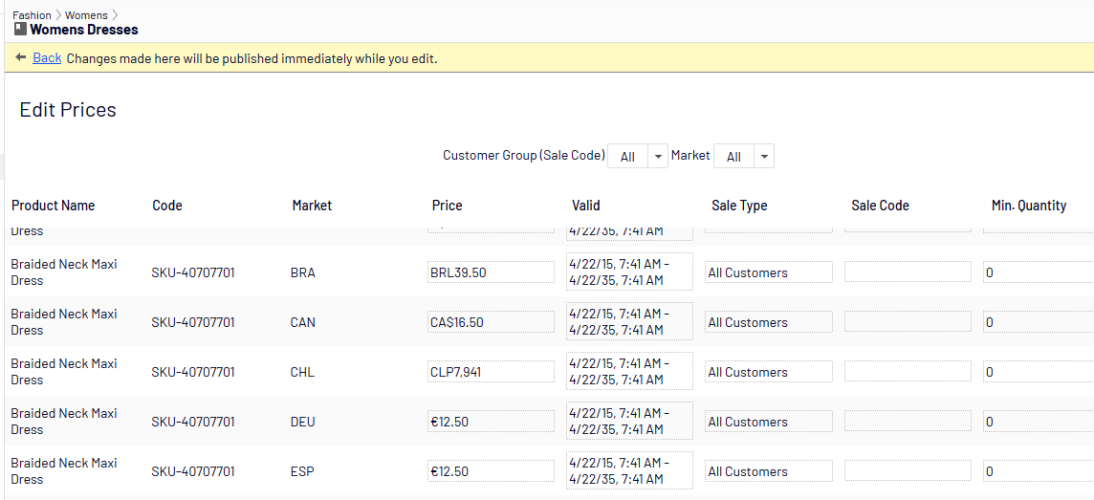 Catalog entry properties
Catalog entry properties
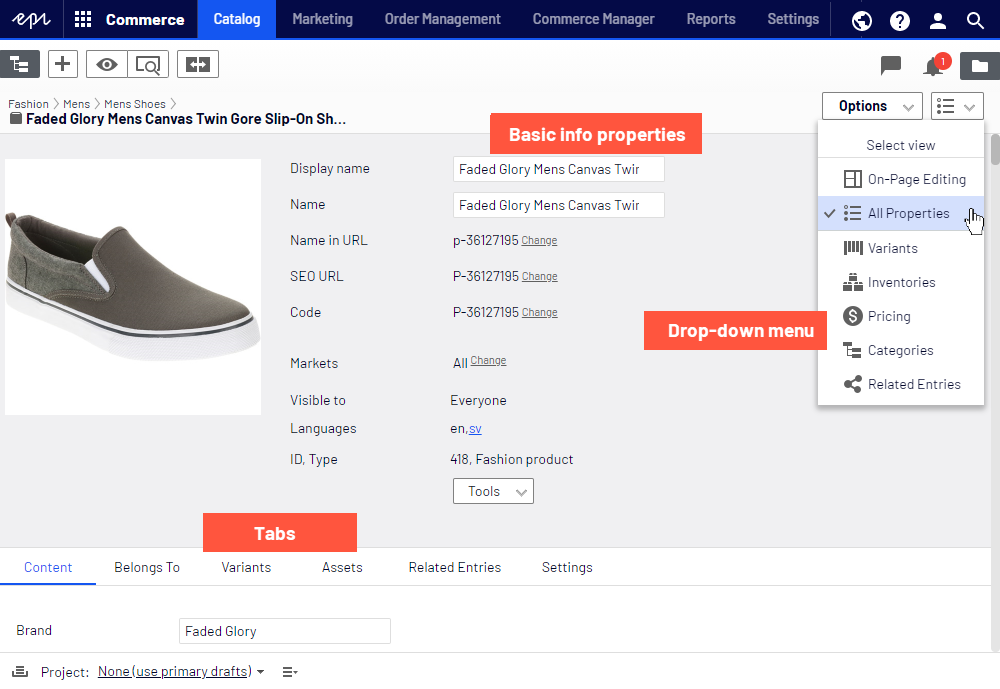
Basic info properties
The basic info properties area provides an overview of catalog entry information. Much of it is created automatically and rarely needs to be changed, unless you manually create catalog entries. Change appears next to some properties. Click it to edit a property value.
- Display name. Name on the content display page.
- Name. Name in catalog item list.
- Name in URL. URLStands for "Uniform Resource Locator". Also known as a web address such as http://world.episerver.com. automatically created, based on name and place in the navigation; whether it is visible in site links depends on implementation.
- SEO URLCorresponds to simple address in CMS. Depending on the site setup, it may be used instead of the hierarchical URL when links are rendered in outgoing responses. For incoming requests, the site always responds to the SEO URL, regardless of settings. For more information, see http://world.episerver.com/blogs/Magnus-Rahl/Dates/2013/12/Replace-SEO-URL-generation-in-EPiServer-Commerce-75/.. Automatically created based on Name; whether it is visible in site links depends on implementation.
- Code. Product code/identification key, often provided by an external system.
- MarketOne or more countries, regions or customer groups, to which you want to apply languages, catalogs, currencies or promotions. The market features support targeted merchandising and personalization.. Markets where the item is available. By default, a product or variant is available in all markets.
- Visible to. Which users and groups can see the item. By default, catalogCommerce: a top-level container for catalog entries such as categories, products, and variants (SKUs). content is publicly visible and editable by CommerceAdmins group members.
- Languages. The content is available in the displayed languages. The active language is not underlined.
- ID, Type. The ID set by the system; the content type upon which the item is based.
Content
The Content tab properties depend on the product or variant.
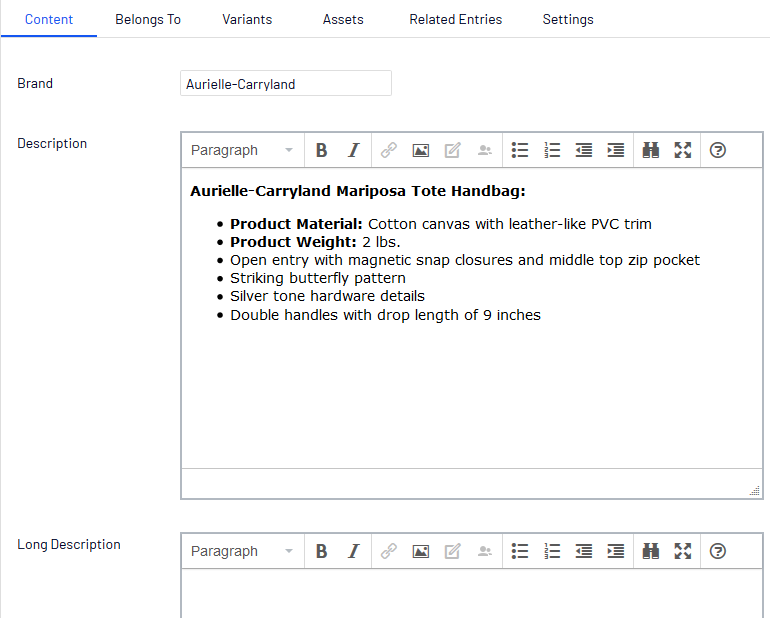
Descriptions can include formatted text, images, and links, using a rich-text editor.
The Links dialog includes the following Commerce-specific properties:
- Catalog content. Lets you assign a link to any catalog entity, such as a catalog, categoryCategories let you adjust the structure and range of a catalog to optimize the selling potential of products. You can use categories to search for products. You can also assign products to categories by creating relations., productCommerce: various forms of merchandise that you can display and purchase from the public site, including products, variations/SKUs, bundles, and packages. Also known as a catalog entry., or variantCommerce: a variant or SKU corresponds to a specific product with specific characteristics. For example, a product line of shirts has individual variations/SKUs that include size, color, and collar size.. For example, if you link to a category, when that link is clicked, a page appears listing all products in that category.
- Marketing content. Lets you assign a link to any marketing campaignCommerce: a set of related components and activities used for promotions. A campaign organizes marketing activity and is associated with discounts (promotions), customer segments, and markets. or promotionCommerce: A way to apply a discount to products, order totals, or shipping; a marketing tool used to increase sales of certain products or product lines. A promotion is associated with a campaign. In recent Commerce versions, this term is replaced by "discount.".
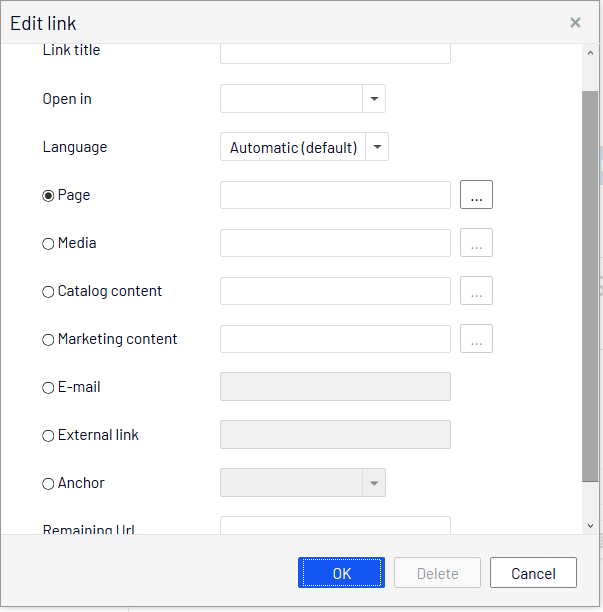
Belongs To
The Belongs To tab displays categories and products, packagesCommerce: a sellable unit that contains variants and/or other packages, with a single price; similar to an SKU because it must be purchased as a whole (such as a computer system). and bundlesCommerce: a collection of packages, products, and variants (SKUs) that let customers purchase two or more items at once. Each item in a bundle is a separate line item in a shopping cart. to which a product or variant belongs. For example, a variant belongs to a product and has a primary categoryCMS: A built-in Episerver property. You apply a category to content, but you need to build the functionality to display the filtered results. Commerce: A grouping of purchasable products. (Same as node.). Also, an item may be part of a Weekly specials category and a Spring package category, as the following image shows. See also: Working with categories.
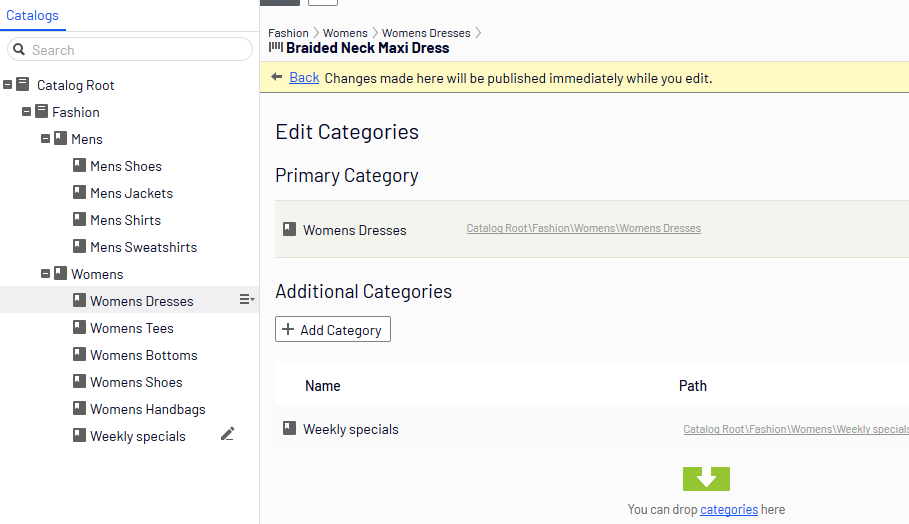
The Edit Prices view lets you view and update pricing for packagesThe .NET (ASP.NET) Framework is a software framework primarily developed for Microsoft Windows. It includes a large programming library and supports several programming languages. Episerver CMS is based on the Microsoft .NET framework. and variants. The view displays a compact list of prices, which can be filtered by marketOne or more countries, regions or customer groups, to which you want to apply languages, catalogs, currencies or promotions. The market features support targeted merchandising and personalization. or customer groupCustomer groups are created in Commerce Manager then applied to contacts and organizations. Customer groups are common to both contacts and organizations, and you can apply them to customer segments that are targeted for marketing campaigns and customer group-specific pricing, including variants.. Market filtering displays both active and inactive markets.
The same item can be available in several markets. For each market, you can define multiple currencies and establish a different price for each one. If you enter no value for any currency, users will not be able to place an order for the item in that currency.
For each product or variant, you can define the following pricing information.
- market
- price
- valid date range
- sale type
- sale code
- minimum quantity
In many cases, pricing information comes from an external system, which may prohibit modifications in Episerver Commerce.
Price changes are immediately available on the website. They are not part of a product's publishing workflow.
Viewing prices
- In the catalog tree, select a category or product.
- From the view selector in the upper right corner, click Pricing.
- If desired, use the Customer Group and Market filters to make it easier to find pricing information.
Only packages or variants with a price appear on the list.
Adding and editing prices
Follow the steps in Viewing prices to access the Edit Prices view. From there, you can complete these tasks.
- To adjust a product's or variant's price information, modify these fields.
- Market. Associate the price with a marketOne or more countries, regions or customer groups, to which you want to apply languages, catalogs, currencies or promotions. The market features support targeted merchandising and personalization..
- Price. The item's price and currency for that market.
The list of currencies is determined by those available for the selected market.
- Valid. The time interval when this price is available.
- To create a future price change.
- Select the item.
- Click Duplicate from the context menu.
- Change the new item's pricing information.
- Set the new available dates.
- To create a future price change.
- Sale Type. Make the price available to All Customers, a specific Customer, or a Customer Price Group. With the last option, you can create tiered pricing (also known as differentiated pricing).
- Sale Code. Use this field to assign a price to a specific customer group. For example, create a new price, select Customer Price Group as its Sale Type, then insert the customer group name into the Code field.
- Min. quantity. The minimum number of units that must be purchased to get the listed price.
Use this feature to provide a bulk rate. For example if a customer purchases 10 or more, the cost is $50.00 each. If fewer than 10, $60.00 each.

- From a product's or variant's context menu:
- click Duplicate to create a copy of price information, which you can then modify to create a new pricing setup.
- click Delete to remove a set of price information.
You cannot undo the deletion of price information.
Setting customer group pricing
Use Customer Groups to set permissions and create targeted marketing campaigns.
Prerequisite: Customer groups are created in Commerce Manager.
To create a customer group price:
- Follow the steps in Viewing prices to access the Edit Prices view.
- In the Edit Prices view, click Add Price.
- Click Customer Price Group.
- Select the customer group to which the price applies.
Inventory (for variants)
Inventory information is often transferred from an external system, so you rarely need to change it. Sometimes you cannot edit it. On other sites, you can update quantities but the other information is read-only.
Inventory screen
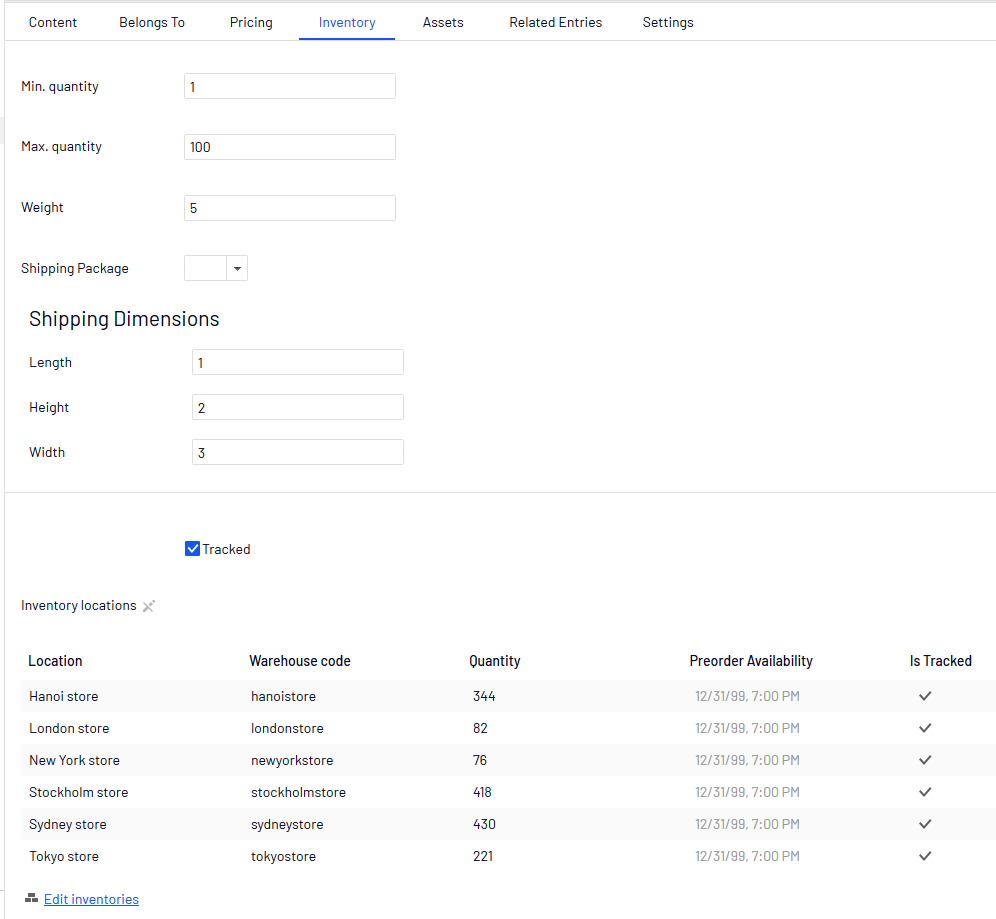
When first viewing a variant's inventory information, you have access to the following information.
- Min. quantity. If desired, set a minimum number of this variant that a customer must buy. If a customer adds fewer than this to a cart, the quantity will be increased to the minimum during cart validation.
- Max. quantity. If desired, set a maximum number of this variant that a customer can buy. If a customer adds more than this to a cart, the quantity will be decreased to the maximum during cart validation.
- Weight. Enter the variant’s weight in your system's weight unit. Weight is used to calculate shipping costs.
Weight unit (kilograms or pounds) is set in Administration > System Settings > Common settings.
- Shipping Dimensions
- Length, Height, Width. Enter the variant’s length, height and weight in your system's length unit. These properties may be used to calculate shipping costs.
Length unit (centimeters or inches) is set in Administration > System Settings > Common settings
- Tracked. If this variant is Tracked, the inventory system is checked for sufficient quantity when someone orders the item. If the variant is not Tracked, orders are filled without referencing the inventory quantity.
Note that each inventory for this variant also has an Is Tracked field. The inventory check is made only if both values are true.
Edit inventory screen

You can view (and possibly edit) the following inventory properties for a product or variant.
- Location. The physical stock location of the inventory, as defined in warehouse settings.
- Code. Product code/identification key; often provided by an external system. Read only.
- In Stock. The quantity of in-stock items for an inventory.
- Backorder Availability. If customers can backorder this item, enter the first date when it is possible.
- Backorder Quantity. The quantity of this item which may be backordered.
- Preorder Availability. If customers can preorder this item, enter the first date when it is possible.
- Preorder Quantity. The quantity of this item which may be preordered.
- Reorder Min. Quantity. The in-stock quantity level at which items should be reordered. For example, when an inventory location has three or fewer items, it is time to order more.
The Low Stock Report uses this value to inform a merchandiser that it is time to reorder. Also, a custom implementation could send email or another alert when in-stock quantity reaches this amount.
- Is Tracked. If selected, shoppers can only complete orders for this product/variant if you provide inventory information from the Inventory Locations. If Is Tracked is not selected, orders can be placed without inventory amounts.
Each variant also has an Is Tracked field. The inventory check is made only if the variant-level Is Tracked field and this one are true.
- Purchase Availability. First date and time when this item can be sold from this inventory.
Variants (for products)
A variant is a version of a catalog entry with specific characteristics, such as price, size, and color. You can perform most of the tasks on a variant that you can perform on a catalog entry. See also: Working with catalog entries.
Assets
Use the Assets tab to link a catalog entry to a media file, such as an image or a document (PDF for example). For example, you want to assign a picture to a catalog entry to accompany its website description.
To add a media file, open the Assets tab, then drag the file from the Media tab to the Assets tab. Or, click Add Media and select the file.
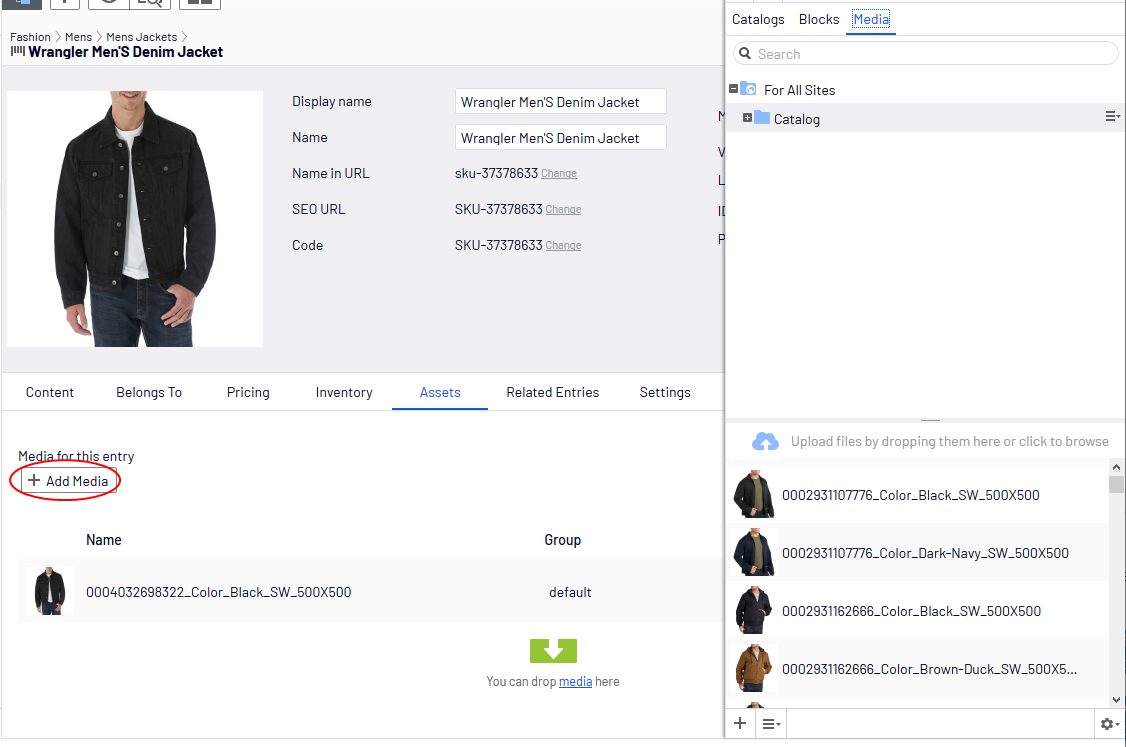
When assigning media files to a variant, you can assign them to a group, such as Banner. You can then sort the files by clicking the Group column header.
To rearrange items in the list, click Move Up or Move Down from the context menu.
On the sample site, the item assigned to the default group at the top of the list is used for the main display.
Related entries
The Related Entries tab lists catalog entries related to the current one. Typical relationship types are cross-sell and upsell. The types are set up by your developer during implementation.
Here is a typical cross-sell scenario: If a site customer views a page with a specific television model, a section of that page is titled ”People who bought this also bought". That section shows HDMI cables and wall mounts that fit that TV model.
To set up those relations, an Episerver Commerce merchandiser navigates to the television, clicks its Related Entries tabs, and adds suitable cables and wall mounts using the type cross-sell.
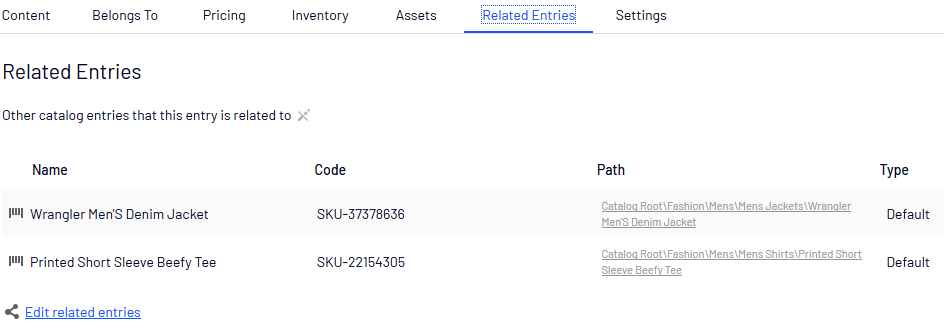
Settings
Settings is a default tab with several built-in, date-related properties that you rarely need to change.
